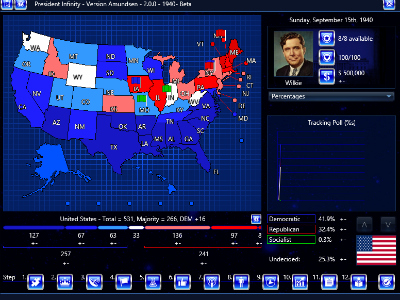The United States watches nervously as Europe and Asia are consumed by warfare. President Franklin Roosevelt finishes his second term. No other president has ever won a third term, but Roosevelt has no obvious successor. Meanwhile, the Republicans, buoyed by gains in the 1938 midterm elections, must decide between nominating an old party hand or a newer, more dynamic candidate. Who will serve as Commander-in-Chief as the crisis grows?
Democratic Candidates:
President Franklin Roosevelt (undecided)—remove Roosevelt for a truly wide-open scenario!
Postmaster General James Farley
Vice-President John Nance Garner
Senator Millard Tydings
Secretary of State Cordell Hull (off)
Secretary of the Interior Harold Ickes (off)
Ambassador to the Court of St. James Joseph Kennedy (off)
Secretary of Agriculture Henry Wallace (off)
Senator Claude Pepper (off)
Solicitor General Robert Jackson (off)
Governor Clyde Hoey (off)
Secretary of Commerce Harry Hopkins (off)
Secretary of Federal Security Paul McNutt (off)
Republican Candidates:
Senator Robert Taft
District Attorney Thomas Dewey
Senator Arthur Vandenberg
Mr. Wendell Willkie
Governor Arthur James
Senator Styles Bridges
Senator Charles McNary
Mr. Frank Gannett
Governor Harlan Bushfield
President Herbert Hoover
Ambassador to Canada Hanford MacNider
Representative Joseph Martin


